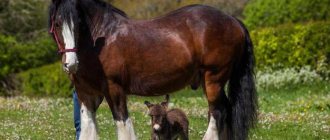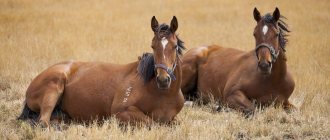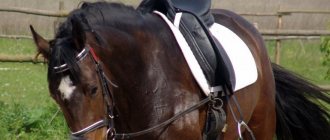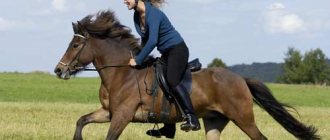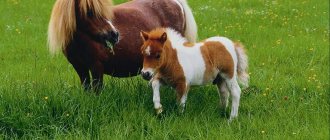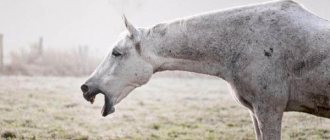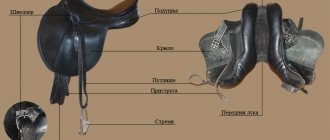Methods for determining pregnancy
It is very important to be able to determine whether a mare is pregnant at home.
It is worth noting that if a horse is carrying a foal for the first time, then the pregnancy process can last longer, which is on average 12 months. The duration of gestation is also influenced by the condition of the mare and many other factors, so it is worth preparing in advance to be ready for anything.
You can find out that a mare is pregnant only in the second week after mating. After intercourse, you cannot be sure that the mare is pregnant. Typically, mares do not become pregnant after the first time. A proven method is to call an experienced veterinarian who can accurately diagnose whether the mare is pregnant. Today, several different methods are presented that indicate pregnancy or a horse with a high level of confidence. It is worth taking a closer look at the two main determination methods.
Diagnostics
To diagnose a horse's pregnancy, clinical examinations can be carried out, and a veterinarian must be present. These procedures include the following:
- blood test - it allows you to determine the level of estrone sulfate and serum gonadotropin, this test can be performed only 100 days after mating, otherwise it will not show the correct result;
- urine test - to determine the presence of estrone sulfate, this option also needs to be done only 100 days after mating;
- transrectal palpation of the horse's uterus is carried out exclusively by a veterinarian; this analysis can only be performed 16–20 weeks after mating;
- Ultrasound examination of the uterine cavity will help to accurately determine the pregnancy of a horse within 2 weeks after mating.
This is interesting! Even before the use of ultrasound, X-rays were taken to determine whether a horse was pregnant or not, but this procedure had a negative effect on the development of the fetus, so it was eventually abandoned.
Traditional methods
To determine if a horse is pregnant without calling a veterinarian, it is worth bringing the mare and stallion together again approximately 3 weeks after the first mating. If the mare is indifferent to him, then this indicates her pregnancy. She will not turn her back to the stallion and raise her tail. At home, you can determine if a horse is pregnant if you carefully monitor its behavior. If she gets pregnant, she will behave normally. If conception does not occur, the following signs of estrus can be observed:
- lifts his tail in front of the stallion;
- squats on the ground to mark territory with vaginal discharge to attract a male;
- the swollen vulva contracts rhythmically from time to time.
Important! The first 100 days of pregnancy are a crisis period, since miscarriages occur quite often during this period, so the mare requires quite careful care
To confirm that a horse is pregnant, you should pay attention to the following accompanying signs:
- the mare begins to sleep longer;
- she begins to lie down longer;
- appetite increases;
- interest in stallions disappears;
- tries in every possible way to keep its territory protected;
- tries to be alone.
Anatomical and physiological changes in the body of a pregnant mare
The absence of heat in a mare after mating may be the first sign of her pregnancy. It causes certain anatomical and physiological changes throughout her body, they are especially noticeable in her genitals and udder. These changes occur under the influence of hormones secreted by the placenta (fetal membranes) and the corpus luteum (a temporary gland formed during pregnancy in the female’s ovaries).
A pregnant horse becomes calmer and more careful while moving. She begins to eat more, the digestibility and assimilation of feed improves in her body, which leads to an increase in nutrition. This also happens due to the fact that a certain amount of protein, fat and glycogen is deposited in her body as a reserve. True, before foaling the fatness of the uterus decreases. This is due to the fact that in the last stages of pregnancy the fetus grows very quickly (in the last one and a half to two months it increases its weight by 2-3 times!). In order to ensure such rapid growth of the fetus, a lot of minerals are required, some of them are practically drawn from the bones and hooves of the horse, so providing the uterus with a complete diet at this time becomes especially important.
From the body of the pregnant female, the fetus receives oxygen and nutrients through the blood, and therefore the work of the heart and respiratory organs increases, and the blood volume increases by 20-30%. The carbon dioxide content in the blood increases, resulting in slight acidosis.
In a pregnant female, the physiological load on the liver significantly increases, because now she must neutralize metabolic products not only of her body, but of the fetus, and the work of the kidneys also increases.
Pregnancy is accompanied by a noticeable increase in the size of the uterus and a change in its location. The weight of the pregnant uterus increases 5-20 times compared to the non-pregnant state. It moves into the abdominal cavity and is located on its left side wall and reaches the diaphragm. Crypts form on its mucous membrane, thanks to which the placenta is attached to its wall. The fibers of the uterine wall become 7-15 times longer and 5-6 times thicker. Despite this, its wall is still thinning. The blood vessels of the uterus thicken and lengthen, many new vessels appear in its wall, and the volume of blood flowing to the organ becomes 4-6 times larger.
The canal in the cervix is filled with a thick, viscous secretion, from which the so-called mucous plug of pregnancy is formed.
In the second half of pregnancy, the female’s abdomen increases in volume, in its lower area (on the left directly above the udder) in the morning, preferably after the animal drinks, you can notice how the fetus moves.
Thus, pregnancy is accompanied by a significant restructuring of the animal’s body, which occurs in connection with the adaptation of its body to new conditions of existence. With proper feeding and maintenance of the pregnant mare, and if she is healthy, this restructuring of her body proceeds quite normally. If the pregnant mare is sick or the conditions in which she is located do not provide the increased needs of her body, then the most severe consequences may occur: abortion, illness of the female, or even her death. Therefore, during this period of the mare’s life, her life and health, as well as the life and health of her fetus, completely depend on the person and his responsible attitude.
Helping a mare to give birth normally
The onset of labor can be determined by the behavioral characteristics of the mare. If she stops eating, behaves anxiously and nervously, sweats and strains, it means that she will soon bear offspring. The mare's udder swells, drops of milk appear from the nipples, swelling appears on the labia, and the depression between the beginning of the tail and the ischial tuberosity expands.
Position of the foal before birth
If an animal is among a herd, it tries to leave it, and if in a separate room, on the contrary, it strives to join society. All this is a signal to action - it’s time to prepare for childbirth.
Preparation for the process
Do not panic during childbirth - all your movements should be calm and calculated. It is best to prepare the room in advance for the appearance of offspring. If you are not experienced enough to give birth, contact your veterinarian. By watching him work, next time you will be able to control the process yourself.
Step 1. Clean the room where the birth will take place in advance. Disinfect equipment with iodine solution. Remember: the pen must be kept dry and warm.
Preparing the room for horse birth
Step 2. Make sure that nothing is interfering with the birth process. Remove unnecessary items and provide your pet with privacy.
There should be no unnecessary items in the room
Step 3. Place dry and clean straw on the floor. If the weather outside is cold, take care of the bedding in advance. Place a clean, coarse cloth under the woman in labor so as not to stain the floor.
Place straw on the floor
Step 4. Dim the lights. If the lighting is bright, it will irritate and disturb the animal.
Bright lighting will irritate the animal
Step 5. Tie the female's tail by carefully folding it and tying it with a bandage. Experienced horse breeders recommend doing this to facilitate childbirth.
Horse's tail tied before pregnancy
How to deliver a horse?
When a mare gives birth, she lies on her side and makes strong efforts, pushing the calf towards the exit. The mare may flick her tail violently, move around the floor, sweat, and jerk her hind legs. Some mares give birth to a foal while standing, then they often change position and become very restless. When the animal pushes the baby up to the chest, the process goes much faster and easier.
Step 1. If the cub is in the correct position (belly down, muzzle and front hooves towards the exit), do nothing, just watch the process
If the mare kicks violently, hold her legs, but do this carefully so as not to frighten the animal
Start of labor
Step 2. The baby appears in a blue-whitish amniotic sac, which ruptures on its own. If the bubble hangs from the birth opening and you can feel the fetal limbs in it, help rupture the membrane, then free the foal's nostrils from mucus.
Amniotic sac of a giving birth mare
Step 3: After about six minutes, the new mother will stand up, breaking the umbilical cord (or it will break if the baby falls from a standing horse). If this does not happen or the umbilical cord breaks further than ten centimeters from the belly, tie it with strong threads (two to three centimeters from the abdomen), cut it with pre-disinfected scissors and treat it with a 5% iodine solution.
The birth of a foal
Pregnancy and childbirth of a horse: how long it lasts and how it goes
Caring for a horse's pregnancy will require responsibility from its owner and can become a significant cause for concern. It is advisable that the horse breeder have a clear understanding of how horses give birth, what assistance to provide to their wards, and also in what cases it is better not to touch a pregnant mare.
The horse owner manages the mare's pregnancy and monitors her condition and behavior.
Mating
Mares become sexually mature at about 1.5 years, but they are still not developed enough to bear full-fledged offspring and then properly care for them. The first matings should occur in a horse only at 3-4 years of age.
Horse breeders who want to provide offspring for their pet at home should allocate a period from March-April to mid-July for the horse to mate. In more severe climatic conditions, in order to avoid the occurrence of colds in the animal, the beginning and end of the period are shifted forward by two weeks.
Moment of birth: what help may be needed
During labor, a horse gives birth to a foal by pushing it outward from the pelvic area. The weight of the baby does not exceed 1/15 of the weight of the mare that gave birth to it. The entire act of birth should normally not take more than half an hour. The baby is born with its muzzle and hooves forward.
In this case, the hooves have the shape of a hoof horn, which allows not to injure the mother’s birth canal. Weak foals are usually unable to assume the required position; accordingly, the birth can be delayed or end in injury (this applies equally to both an adult animal and a calf).
For this reason, it is better not to try to help the horse produce a foal on your own, but to call a veterinarian.
If the horse shows signs of anxiety, you should try to fix its position by holding its legs so that it does not kick. The most difficult thing for a horse is to push the foal to the middle of the chest. When this milestone is overcome, then the fruit continues its movement very easily.
The mother horse copes with the rupture of the umbilical cord on her own and gets back to her feet almost immediately, but if the horse has given birth for the first time, it may take up to 10 additional minutes to rest.
In the first seconds, the foal is inside a white-blue amniotic sac, which should rupture spontaneously (otherwise you will have to help him).
If, after the horse is on its feet, the umbilical cord remains intact, it is necessary to tie it with a strong thread 2-3 centimeters from the abdomen, cut off the excess with sterile scissors and disinfect it with a 5% iodine solution.
When the condition of the foal and mother has stabilized, the first should be thoroughly wiped, and the second should be washed with warm water.
The mare independently gnaws the umbilical cord, cleans and licks the foal.
Conclusion
If a horse becomes pregnant, you should not overprotect it and worry. Experiences can easily be transferred to the animal and, possibly, interfere with the normal course of pregnancy.
There is no need to move away either, it is better to stay nearby all the time, but at a distance, then you will not “put pressure” on the horse and will be able to help it in time if necessary.
You should agree in advance (before the onset of labor) with the veterinarian about his readiness to be present and provide first aid in case of injury. And, of course, during pregnancy, provide the expectant mother with a preventive examination.
Moment of birth: help
Typically, the process of giving birth to a foal lasts 30-40 minutes. The calf may be born with its muzzle or hooves forward. Mostly horses are born, like people, head first.
How do horses give birth?
When a horse becomes nervous, it needs to be helped to calm down. If she kicks, her legs are fixed.
After the birth of a calf, the young mother usually copes with the rupture of the umbilical cord herself. But after 10-15 minutes, the umbilical cord must be bandaged and disinfected with iodine.
A newborn calf is in a bluish membrane - the amniotic sac. If the foal cannot rupture the bladder on his own, he will have to be helped. After which the foal must be washed with water at room temperature and dried.
Foaling (birth) in mares
Childbirth in mares is called foaling, i.e. the birth of a foal. They pass within 30–40 minutes, but the first signs of foaling may appear 2–3 days before the onset of contractions.
Find out what to feed your horse and what supplements to use to keep its hooves, coat and joints healthy.
Preparing the premises
Labor in horses begins late at night or early in the morning and usually lasts about half an hour if it occurs without complications. Start preparing for foaling several hours before the expected time. Clean the foal horse's stall, disinfect it and cover it with fresh deep bedding; dim the lights in the stall.
It is also recommended to cover the bedding with clean natural fabric. Shortly before giving birth, the horse begins to turn around on its croup, worry, lie on its side and sweat profusely. At this point, you need to clear the stall of strangers and not disturb the mare in the future.
How to prepare for foaling: video
Important! A horse before foaling can behave calmly. In this case, a sure sign of impending labor will be a large amount of mucus on her labia and frequent attempts to rub her tail against the walls of the stall.
How do horses give birth?
If the foaling proceeds without complications, the foal emerges from the birth canal with its hooves and muzzle forward. The hardest part is the foal's chest. Further labor takes no more than 5 minutes. During labor, the mare may roll around on the floor, wag her tail, and kick her hind legs.
The veterinarian only intervenes if the fetus is in the wrong position in the womb or the horse is too weak to push it out on its own. He can hold the horse's legs or help the fetus move through the birth canal.
Did you know? Until the first decade of the 20th century, the problem of horse manure and urine was the most serious pollution problem in European and American cities. At the end of the 19th century, New York had a half-million horse population to make up for the lack of transportation, and only the advent of cars three decades later could solve this problem.
The baby begins to stand on its feet 40–50 minutes after birth. During this time, you need to wash the horse's udder and hind legs with warm water and change the soiled bedding.
A horse that has not previously given birth will usually rest for 10 to 15 minutes and then begin licking, sniffing and nipping the foal to get it to its feet. The baby begins to feed on mother's milk an hour and a half after birth.
Important! Two and a half hours after birth, the foal should pass meconium (first feces). If this does not happen, it is necessary to stimulate defecation by inserting a finger into the foal's anus or giving him a few tablespoons of castor oil. If the sucking reflex does not appear during this time, wait another half hour, milk the mare and give the foal milk from a bottle.
If the sucking reflex does not appear during this time, wait another half hour, milk the mare and feed the foal milk from a bottle.
Childbirth
Childbirth is characterized by intense pushing in the horse, which pushes the foal to exit through the birth canal. How long does this process take? It is said that the weight of the fetus is 1/15 of the weight of the mare. Labor usually lasts just over 30 minutes. The foal's hooves and muzzle appear outside.
There are cases when the foal fails to take the appropriate position in the uterus and begins to emerge with its hind legs. In this case, you should not pull it yourself; you can irreparably injure both the little one and the mare; here only a specialist can provide assistance. If the animal is worried, then you can hold its legs so that it does not have the opportunity to kick.
The most important part for a horse in the birthing procedure is to try to push it out of the birth canal to chest level. After that, he comes out without much stress. As soon as the foal is born, the mare stands up and breaks the umbilical cord, only first-time mares will need a short period of time to rest. The baby is born “in a shirt”, an amniotic sac of a bluish tint.
The mare cuts the umbilical cord herself
Size of litter per foal
How many foals a horse can give birth to at one time depends on its breed. It is considered normal to carry one fetus. It is very difficult to carry two embryos healthy. The likelihood of twin calves being born alive is very low. The possibility of becoming pregnant with twins is a birth feature of some horse breeds.
A newborn foal should weigh between 40 and 60 kilograms. The weight of a newborn depends on the weight of the mother, her physical condition, and breed. The normal weight of a foal should be 10-15% of the mother's weight.
Occasional period
The queens reach sexual maturity by the age of one and a half years, but this period is not sufficient for coverage, because the animal has not yet fully formed physically. Therefore, there may simply not be enough strength to bear full-fledged offspring and care. The first mating is recommended when the horse reaches the age of three to four years.
recommended articles:
It is best to organize mating in March–April, maximum in mid-July. If the farm is located in an unfavorable climate, then it is recommended to move these deadlines forward by 14 days. This technique allows you to prevent colds in young animals.
Mating of horses
Definition of pregnancy
If we talk about visual signs, they appear only from the sixth month after successful coverage. To diagnose pregnancy early, you can use an ultrasound or take tests to a veterinary laboratory. It is worth noting that both of these methods are not the cheapest.
The first samples are taken a week or two after mating. Another way to determine the presence of a fetus is by palpation of the uterus and abdomen. If there is a compaction on the left side, then this is the sign that indicates the presence of a fetus.
A number of signs can also be used to judge whether a horse is pregnant:
- the animal sleeps more than usual;
- in the later stages, the mare prefers to spend a lot of time lying down;
- appetite increases;
- the queen does not come into heat;
- It is common for pregnant mares to protect their territorial possessions;
- when kept in a herd, the horse tries to stay separate from its relatives;
- A few days before foaling, you can notice an increase in the udder.
How is pregnancy progressing?
The entire pregnancy can be divided into periods, the duration of which is approximately 111 days:
- formation of the embryo and membranes;
- the embryo appears similar to a foal;
- active growth and weight gain of the fetus.
Excessive physical activity and stressful situations are contraindicated for pregnant mares. There should be no drafts in the stables, and the floors in the stalls are covered with a thick layer of bedding, which must be padded daily. In the summer, it is better to place mares indoors at night and not leave them on pastures.
On days 60–90 after favorable coverage, the uterus may experience something similar to estrus. In such circumstances, it is necessary to invite a veterinarian for an examination (before re-breeding).
Pregnant mare
Very cold water and expired feed lead to miscarriages, and therefore the nutrition of the pregnant mare must be carefully monitored. 90–120 days before the expected foaling date, the feeding rate increases by 40%. Feeding consisting of small portions several times a day is recommended. If possible, special mixtures for pregnant mares, which are rich in vitamins, are added to the feed. In the absence of such fertilizers, grass flour, carrots, and apples are suitable.
14 days before the due date, the mare must be completely removed from work. However, it is worth remembering that the animal must be provided with regular walks in levadas during this time (depending on weather conditions).
How long does pregnancy last in horses?
Mares remain pregnant for 341 days, which is approximately 11 months. If everything proceeds normally, then this is the time it takes to become pregnant. Depending on seasonality, development, fruit size and food supply, the period can be slightly increased or reduced to 14 days (both up and down).
Childbirth process
As for assistance during childbirth, it is worth quoting the words of a very good veterinarian: “The main help is not to interfere.”
Horses most often give birth to one foal, less often a pair. Such twins are characterized by insufficient weight and bitterness. There is a high probability of death of one or two foals at once. However, with timely human intervention, you can try to get both of them out. If the mare refuses to feed the young animals, then they are transferred to artificial feeding. If the uterus accepts only one foal, it makes sense to take the second one away, transfer it to another stall, and provide direct care there.
Animals prefer to give birth lying down, in some cases standing. The process itself consists of strong attempts. At this time, the fetus is emerging from the uterus, it moves forward at regular intervals. At this moment, the mare may become covered in sweat, wag her tail, buck and even roll on the floor. All this is completely normal behavior, and there is no need for a person to interfere.
Correct presentation of the fetus is determined by the fact that the forelimbs on which the foal's head rests are first born. As soon as the foal comes out along the chest, the owner can exhale with relief: there will be no problems with the rear part coming out.
Malpresentation is characterized by the birth of the hind limbs, which can significantly complicate the birth process. In this case, you need to call a veterinarian. The owner should absolutely not try to pull out the foal on his own. Inept actions lead to injuries to newborns and adult animals.
It is typical for firstborns to spend several minutes after foaling in a lying state, which helps to restore strength. Mares that have given birth more than once often get up immediately. This movement causes the umbilical cord to rupture. In the event that the gap does not occur, the owner will have to do this. Circumcision is carried out using sterile scissors at a distance of 12 cm from the foal's abdomen. This is followed by dressing with threads soaked in alcohol at a distance of 3 cm. The tip of the umbilical cord is cauterized with iodine.
The birth process takes from half an hour to 40 minutes. If a mare gives birth to twins, the second foal appears 20 minutes later.
If the foal was born in an unruptured amniotic sac, then a person will need to rupture it. If necessary, the nasal cavity is cleared of mucous secretions so that the newborn can breathe.
Pregnancy in horses
Pregnancy occurs from the moment of insemination, but since the mare is inseminated several times during the heat, it can be difficult to determine the exact date of fertilization.
How to determine
There are four ways to determine pregnancy: folk, clinical, instrumental and laboratory.
Folk way
Visual changes become noticeable in the fifth month of pregnancy. The mare's abdominal walls begin to bulge, and her left side becomes more rounded and drooping. When covering the mare with a sheet and listening to the peritoneum with a phonendoscope, the heart sounds of the foal are heard.
You can also check the presence of a fetus by palpation. When you press on the side of the mare, the fetus will move from its place, and then return to it with a noticeable push
Palpation should be carried out as carefully as possible; under no circumstances should you press with your fist or hit the mare on the side. These methods are effective for late pregnancy
Diagnosis of pregnancy by external signs: video
Clinical method
Includes rectal and vaginal examinations. They are performed by inserting a gloved hand into the anus or vaginal opening of the mare.
The vaginal method is rarely used, since during the examination the fetus can be damaged and infectious diseases can be introduced. The rectal method gives an accurate result.
Instrumental method
Ultrasound examination is considered the most informative and safe for the mare and foal. Ultrasound makes it possible to determine pregnancy already on the tenth day after fertilization.
After fixing the animal and defecating, a sensor lubricated with lubricant is inserted into the anus. It is passed along the mucous membrane and with its help the uterine horns are examined. On the tenth day of pregnancy, an embryo will be visible on the display, on the twentieth - an embryo. This is the most reliable way to diagnose pregnancy.
Ultrasound of a pregnant mare
Laboratory method
It involves taking a blood test and a smear from the vaginal mucosa. In the third week after insemination, the level of progesterone, the pregnancy hormone, rises in the mare’s blood. Progesterone protects the fetus from abortion and inhibits the sexual activity of the mare.
A smear of mucus is checked on a glass slide after treatment with alcohol and staining. If the horse is pregnant, the mucus under a microscope will appear as small blue balls interspersed with fragments of epithelium and individual white blood cells.
The mucus of a horse that has not been fertilized will appear uniform and consist of white blood cells along with squamous epithelium. This method is considered not the most reliable; it can be used starting from the fourth month of the expected pregnancy.
How long does it last
The average gestation period is between 320 and 350 days. The duration of pregnancy depends on the size of the fetus, the breed of the mare and stallion, the duration of estrus, the number of matings, and the conditions under which the animal is kept. There is an opinion among veterinarians that females are born on average two weeks earlier than males.
The maximum number of foals obtained from one foal is two. If a mare carries two foals, she will become significantly emaciated and both foals will be born weak or dead. Most often, one fetus is stillborn and the other is healthy. Normally, a mare carries and gives birth to one foal.
Mare's pelvis
The mare's pelvis has a structure conducive to an easy course of labor. The ilia are located to the level of the pelvic floor at an angle of 50-60 degrees; as a result, the entrance to the pelvis has an oblique direction, facilitating wedging of the fetus. The apex of the vertical diameter of the pelvis falls on the fourth sacral vertebra. The shape of the entrance to the pelvis is oval, almost round. The pelvis has:
The entrance communicates with the abdominal cavity and is limited by the sacral, ilium and pubic bones.
The exit from the pelvis is formed from above by movable caudal vertebrae, from the sides - by the sacrosciatic ligaments, and from below - by the ischial bones, which have minor ischial tuberosities and a large sciatic notch. The pelvic cavity is the space between the inlet and outlet; it has a vault - an upper wall, side walls and a bottom.
The pelvic arch consists of the sacrum and the first caudal vertebrae.
The lateral walls of the pelvis are formed by the innominate bones and broad pelvic ligaments, and its bottom is formed by the branches of both pubic and ischial bones, connected to each other by cartilage, merging into the pelvic fusion. Each innominate bone consists of the pubic, ischial and ilium bones, which develop from independent segments and fuse at the articular surface for the hip joint. A significant part of the lateral walls of the pelvis consists of wide pelvic ligaments that protrude to the sides when the fetus is removed and thereby facilitate its easy passage through the pelvic cavity.
The pelvic floor is formed by the branches of the pubic and ischial bones, fused along the medial line, which creates a flat convex or concave surface. The entrance to the pelvis has the shape of a laterally flattened oval.
Preparing for horse birth
Childbirth in a horse is a crucial moment
It is important to carry out regular deep cleaning of the stall. Accordingly, at a period of 10-11 months it is necessary to clean the place where the birth will take place
A new and warm bedding should be laid on the floor, the light should be adjusted: it should not hurt the eyes, but at the same time it should be enough for the comfort of the person controlling the process. Providing a calm environment is essential for both the veterinarian and any individual. But most of all, this is important for the horse itself, so that its offspring are healthy and the birth process goes without complications.
It is recommended to tie the mare's tail with a clean cloth, which can be pre-treated with an antiseptic for complete sterility.
Before giving birth, it is important to slightly adjust your diet. When the baby does not appear on time, it is better not to overfeed the female; you need to give her light food, and also monitor the availability of clean drinking water.
At the same time, you need to feed the female with food rich in minerals and vitamins.
Feeding, housing, use and care of a pregnant mare
During pregnancy, an animal is under strong physiological stress, so adequate feeding, proper maintenance and use, and good care are very important and often determining conditions for the normal course of pregnancy, maintaining the health of the mare, good fetal development, successful completion of labor and the birth of a healthy offspring. .
The general requirements for feeding a pregnant uterus are as follows:
- Her diet must fully meet her body’s need for nutrients; it must contain sufficient amounts of proteins, sugars, minerals and vitamins.
- The food included in the diet must be easily eaten and of good quality.
- Rotten, sprouted, moldy, frozen, and poisonous food is excluded.
- It is necessary to provide pregnant females with lick salt.
- In the summer, it is better to keep the mare on pasture, since fresh air, sun, fresh grass, and the animal’s relaxed movements have a beneficial effect on her health and contribute to the normal development of the fetus. For them, pastures of the highest quality in terms of grass and availability of water sources, free from snags and holes, are allocated, the duration of grazing and the time of watering are established; Where required, females are fed with green and concentrated feed.
- In the autumn, when the time for grazing is reduced, it is necessary to strengthen the diet in a timely manner so that pregnant animals do not starve and do not lose fat.
- When kept in stalls, animals should receive the best quality hay, silage, root crops, and concentrated feed.
- During the winter period, special attention must be paid to the completeness of diets in terms of vitamins (especially carotene) and calcium and phosphorus salts, and if their quantities are insufficient, include feed rich in vitamins (green feed, silage) in the diet; add fish oil, bone meal, chalk. For preventive purposes, introduce concentrated vitamin preparations into the food or intramuscularly.
- It is necessary to ensure free access to quality drinking water.
In addition to ensuring good nutrition, the following conditions must be met for its maintenance and use during pregnancy:
During the stall period, mares must be placed in comfortable, dry premises with sufficient light and good ventilation.
The premises and the animals themselves must be kept clean and provided with clean and dry bedding.
In the spring, after animals are turned out to pasture, and in the fall, before they are placed in winter housing, the premises are thoroughly cleaned, disinfected and whitewashed to prevent infectious diseases.
For pregnant females during the stall period, daily exercise is necessary when kept in pens, but it is better to keep them freely in the levada to avoid the development of edema and postpartum complications.
Mares with a six-month pregnancy are exempted from heavy work, and two months before foaling and for two weeks after it they are exempted from all work.
Childbirth
Eleven months are behind you and you are expecting your mare (or pony) to give birth.
You don’t need to be near the expectant mother 24/7, but it is important to make sure that there is always clean water and food near her. A mare (pony) should not be fat, but at the same time it must receive a sufficient amount of nutrients. You can make a video report about the progress of your pregnancy or make notes in a notebook
You can make a video report about the progress of your pregnancy or make notes in a notebook.
Preparation
Two weeks before the expected due date (according to ultrasound diagnostics), the horse must be transferred to a separate pen where it can give birth. It is better to lay straw on the floor, and dim the lighting. There should be no strangers, animals or loud sounds. The designated area where the birth will take place should be warm and dry. It is advisable to disinfect this area or pen before the mare is placed in a separate stall. If it was here before, then it will be enough to simply change the straw bedding and place a cloth or oilcloth under it for birth discharge.
Before giving birth, a horse (pony) needs to be fed more, but in small portions. A mare, whose height is about 150 cm at the withers, during the second period of gestation must eat at least seven kilograms of food per day containing healthy proteins, vitamins, proteins and other substances. Special food and vitamin supplements for pregnant and lactating horses can be purchased at appropriate stores and pet pharmacies.
There is no need to limit the mare's physical activity from the very beginning of pregnancy. Just as the fetus grows, their number should be reduced. Riding a mare (pony) in position is allowed if there are no special contraindications for this.
How does the process work?
When a woman in labor begins a period of pushing, this becomes noticeable in her behavior. In most cases, the horse exhibits restless behavior: it sometimes walks actively, but sometimes it can also lay down. The birth itself takes place in a lying position. When the time comes, the water first recedes, then a membrane film begins to appear, which ideally should be white with a blue tint.
If there are noticeable blood impurities in it, this means placental abruption, which in turn indicates a cessation of oxygen supply to the baby’s body. In this case, the presence of a veterinarian is necessary.
The foal is born with its front legs and head. If the position is incorrect, then the woman in labor will most likely need help. To determine the position of the fetus in the later stages, an ultrasound diagnosis can be performed, based on the results of which the veterinarian makes a conclusion about how the upcoming birth should proceed.
Once the foal's front legs and head have emerged, the rest of the foal slides out easily and quickly.
Next, it is important to free the baby from the membrane so that he can breathe. If there are difficulties in breathing, then in this case you should ventilate the oral cavity, free it from blood clots and other particles that may impede the penetration of air
If the pregnancy continues normally and the fetus is positioned correctly, then human intervention in the natural process of the birth of a foal should be minimal. Well, sometimes it is simply necessary to preserve the life of a newborn and maintain the health of his mother. Before you decide to attend the birth, we recommend that you study all the information on this topic.
How to help a horse during labor
In order to ease the lot of the woman in labor, you can be present next to her, but in no case interfere
But it is important that the mare (pony) knows you very well, otherwise the presence of a person nearby may cause anxiety for the expectant mother. You can push the fetus towards the exit and change its position only if you are well acquainted with the technique
What to do after babies are born
When the foal has already been born, the mother horse can suddenly stand up and break the umbilical cord too close to the baby's tummy. To prevent this from happening, it is better to cut the umbilical cord and tie it in a knot. If there is a tumor on the foal's belly, then it is better to ligate the umbilical cord as high as possible so as not to catch this swelling. The whole process takes very little time.
In this touching video, a mother horse eats grass with her foal.
If a few hours after birth the newborn does not begin to suck the udder, then it should be expressed and given to the foal. After all, it is with colostrum that he receives valuable immune substances for his body that will help him survive and become healthy. The mother mare will do the rest: she will lick her child and will subsequently feed him milk.
